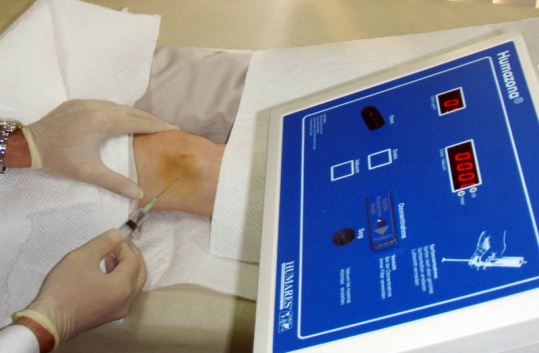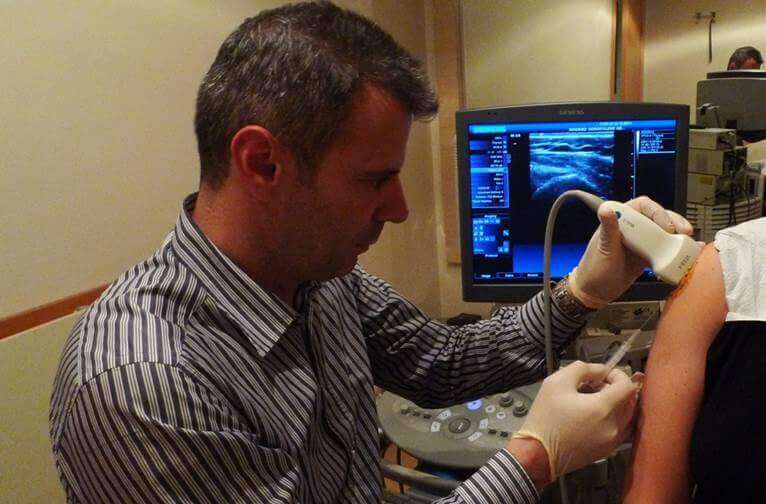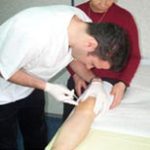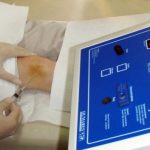Special Injections
Special injections are among the most significant therapies. The medications administered into the injection site speeds up the process. It is a highly preferred treatment choice with reduced labor and costs. Under the scope of physical therapy, local injections can be administered for joint diseases (intraarticular, periarticular), trigger points in the muscles, spinal painful diseases and soft tissue disorders (tendons, ligaments, nerves). Mostly cortisone, local anesthetics, Na hyaluronate, special medication mixtures (prolotherapy), botulinum toxin (botox, dysport), PRP (platelet rich plasma), ozone are preferred for these injections. In some cases needling without medication or injection may provide relief (dry needling).

Cortisone Injections
Administered into soft tissues and intra-articularly. Usually given with local anesthetics for pain relief and a good level of distribution. This is by far the most preferred injection method and provides a high level of efficacy. Patients do not experience the majority of the side effects of cortisone as it is only administered single dose. In some cases, high blood pressure may cause temporary increases in blood glucose and flushes for patients with diabetes. These side effects can be controlled and thus, cortisone injections are highly safe. Arthritis, special joint diseases (shoulder, knee), tendon and ligament disorders (tennis elbow, golfer’s elbow, tendinitis), special spinal disorders, spinal and cervical disc herniations are among the common disorders for which local cortisone injections are administered. It can be administered up to 4 times for a particular joint but usually, 1 injection provides efficacy for about 6 months to 1 year. It provides a high level of efficacy in tendon injections and a single dose can provide a permanent relief. In some disorders such as tennis elbow about 30-40% of the patients may experience relapse.

Na Hyaluronate (Cartilage Injection)
 A special injection administered intra-articularly. A lubricant fluid with high molecular weight, including Na Hyaluronate which is one of the primary materials of joint cartilage. This fluid covers the cartilage surfaces decreasing the friction coefficient of cartilage damaged due to arthrosis. Single dose and triple-dose injections (with one-week intervals) are commercially available. It should be repeated with 6 months-1 year intervals since it only provides temporary relief. It is most commonly administered into the knee while it is also injected into hip, shoulder, mandibular joint, wrist-thumb joint. Except from local allergy reactions for a couple of days with a low incidence rate, there are no side effects.
A special injection administered intra-articularly. A lubricant fluid with high molecular weight, including Na Hyaluronate which is one of the primary materials of joint cartilage. This fluid covers the cartilage surfaces decreasing the friction coefficient of cartilage damaged due to arthrosis. Single dose and triple-dose injections (with one-week intervals) are commercially available. It should be repeated with 6 months-1 year intervals since it only provides temporary relief. It is most commonly administered into the knee while it is also injected into hip, shoulder, mandibular joint, wrist-thumb joint. Except from local allergy reactions for a couple of days with a low incidence rate, there are no side effects.
Ozone Injection
 Ozone injection is the direct injection of low level of ozone and oxygen mixture into the relevant site. Ozone injection causes various physiological impacts on the injection site. It inactivates chemicals that cause pain, provides anti-rheumatic effects and relief. Ozone injection is preferred in the treatment of spinal and cervical disc herniation, myofascial pain (muscle cramps) and arthrosis. It is especially used in the cases of knee arthrosis. Usually administered 3-5 doses with a couple of days intervals. It can provide efficacy of several months to a year. Ozone injection is most commonly used in the cases of spinal and cervical disc herniation. Especially for the cases of spinal disc herniation, ozone injection into the paraspinal muscles is highly effective and provide pain relief even with just one dose. This method provides efficacy for patients with acute sciatica pain in the legs. It is administered at least 6 doses with several days of intervals for mild cases and 10 doses -and rarely more- for severe cases. There is almost no side effect of ozone injection. Intra-articular injections are relatively pain-free while muscular injections may cause temporary pain for some cases.
Ozone injection is the direct injection of low level of ozone and oxygen mixture into the relevant site. Ozone injection causes various physiological impacts on the injection site. It inactivates chemicals that cause pain, provides anti-rheumatic effects and relief. Ozone injection is preferred in the treatment of spinal and cervical disc herniation, myofascial pain (muscle cramps) and arthrosis. It is especially used in the cases of knee arthrosis. Usually administered 3-5 doses with a couple of days intervals. It can provide efficacy of several months to a year. Ozone injection is most commonly used in the cases of spinal and cervical disc herniation. Especially for the cases of spinal disc herniation, ozone injection into the paraspinal muscles is highly effective and provide pain relief even with just one dose. This method provides efficacy for patients with acute sciatica pain in the legs. It is administered at least 6 doses with several days of intervals for mild cases and 10 doses -and rarely more- for severe cases. There is almost no side effect of ozone injection. Intra-articular injections are relatively pain-free while muscular injections may cause temporary pain for some cases.
Watch Ozone Injection Video
Injections of Local Anesthetics
It is usually administered with a mixture of cortisone,. This is one of the most preferred methods for the treatment of myofascial pain trigger points (shoulder pain – muscle cramp). For the treatment of such muscle pain, it is usually given in several doses of 1-2 cc and provides a high level of efficacy in combination with stretching exercises. There are rare side effects due to the low amount of medication it includes. In some cases, it may be given to reveal the source of pain while it may be used to relieve pain prior to some treatments.
Watch Injections of Local Anesthetics Video
Btulinum Toxin (Botox Injections)
Botulinum toxin is a very poisonous toxin of some kind of a bacteria. It causes a certain level of paralysis on the muscle, impacting on the neuromuscular transmission. Paralysis lasts 3-4 months. Thus, this method is preferred for the treatment of severe muscle spasticity developed in the cases of palsies (stroke, hemiplegia, paraplegia, spastic paraplegia), involuntary movements, muscle spasticity in children with cerebral palsy, distonia (writer’s cramp, musician’s cramp), tension-type headache, heavy sweating in hands. It is also used very commonly for eliminating wrinkles in cosmetics sector. In rehabilitation medicine, it is most commonly used for the treatment of muscle spasticity developed in cases of strokes. The relevant muscle is numbed for 3-4 months to improve the efficacy of rehabilitation in the meantime. The physician may decide repeating the injections based on the condition and response to the treatment. For young children, it is usually administered under anesthesia. There are no side effects unless administered with a high dose. The antibodies produced upon repetitive injections may decrease the efficacy of the injection. The most outstanding disadvantage of the method is its high cost.
Watch Btulinum Toxin (Botox Injections) Video

